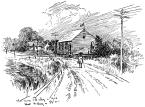After thirty years serving the Heritage Museums & Gardens in Sandwich on Cape Cod, horticulturist Jeanne Gillis said she still loves to work with people and plants.
Speaking before the Martha’s Vineyard Garden Club at its October meeting, Ms. Gillis presented more than thirty colorful slides in a talk titled Flowering Plants for the Landscape.
Many of the plants featured in her talk are strong and able to survive high winds.
Ms. Gillis singled out the flowering quince, planted by early New Englanders, as not only versatile but, in her words, one tough plant.
A lovely tree like the native Chionanthus virginica, or fringe tree, drew an appreciative response from the audience. The 80-year-old multiple-stem, spreading tree is a regular show stopper at the Heritage Gardens.
A beautiful variety of Deutzia gracilis or slender deutzia is characterized by its chardonnay pearls that bloom in early June. Like many of the trees presented in the talk, Deutzia loves the shade and is especially tough.
Dictamus albus, or gas plant, could be problematic despite its fragrant June blooms. It’s thought that the plant may cause a rash.
An October blooming tree is the species Franklinia, which originates in Philadelphia. Another tough variety is Exochorda racemosa or pearlbush, characterized by gorgeous white flowers.
While stressing the desirability of growing plants which will naturally adapt to their growing area, Ms. Gillis said a number of desirable varieties will require the addition of organic matter to the soil.
The Bottle Brush Buckeye, which requires some compost in the planting hole, will take to a shady location and spread nicely into a clump.
The key to growing lilac is lime, lime, lime, and fertilizer. Lilacs will grow in sun or shade and benefit from a rejuvenation pruning in February. Still, the general rule applies with all flowering plants: no pruning until the plant flowers or immediately after.
While Fothergilla major is yet another example of a tree that needs added organic matter, it boasts spring flowers that come before its leaves, which eventually turn into a beautiful fall foliage.
Ms. Gillis does not think that Albizia julibrissin, or silk tree, and Heliopsis helianthoides, or False Sunflower, are invasive as they are easy to weed out.
The slides offered so many possibilities in the garden. According to Ms. Gillis, “The more plants you have, the happier you are.”






Comments
Comment policy »